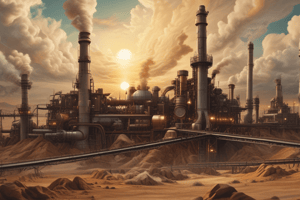Podcast
Questions and Answers
Which of the following best describes a renewable resource?
Which of the following best describes a renewable resource?
- A resource that is primarily used for energy production.
- A resource that is only found in specific geographic locations.
- A resource that is finite and cannot be replenished.
- A resource that can regenerate naturally over time. (correct)
Fossil fuels like oil and coal are examples of renewable resources.
Fossil fuels like oil and coal are examples of renewable resources.
False (B)
What province in Canada is the primary location for oil production?
What province in Canada is the primary location for oil production?
Alberta
Diamonds in Canada are extracted from ________ pipes.
Diamonds in Canada are extracted from ________ pipes.
Match the following forestry practices with their descriptions:
Match the following forestry practices with their descriptions:
Which of the following is a potential negative environmental implication of clear cutting?
Which of the following is a potential negative environmental implication of clear cutting?
GDP represents the total value of goods and services imported into a country.
GDP represents the total value of goods and services imported into a country.
Define the term 'externalized costs' in the context of resource production.
Define the term 'externalized costs' in the context of resource production.
________ obsolescence involves designing products with a limited lifespan to encourage frequent replacements.
________ obsolescence involves designing products with a limited lifespan to encourage frequent replacements.
What is the primary goal of resource management?
What is the primary goal of resource management?
The Linear Materials Economy focuses on sustainable consumption patterns.
The Linear Materials Economy focuses on sustainable consumption patterns.
Name one stage of the Linear Materials Economy.
Name one stage of the Linear Materials Economy.
________ communities often have traditional knowledge that contributes to sustainable resource management.
________ communities often have traditional knowledge that contributes to sustainable resource management.
Why is the involvement of Indigenous communities important for resource management?
Why is the involvement of Indigenous communities important for resource management?
Prioritizing economic growth always leads to environmental sustainability.
Prioritizing economic growth always leads to environmental sustainability.
Match the following type of obsolescence with their descriptions:
Match the following type of obsolescence with their descriptions:
What percentage of the world's freshwater does Canada hold?
What percentage of the world's freshwater does Canada hold?
Which of the following terms refers to marketing strategies that make consumers feel their products are outdated or undesirable, prompting new purchases?
Which of the following terms refers to marketing strategies that make consumers feel their products are outdated or undesirable, prompting new purchases?
Canada's GDP is approximately 1.6 million dollars.
Canada's GDP is approximately 1.6 million dollars.
The economic and environmental implications of ______ sands extraction are often referred to as 'Black Gold'.
The economic and environmental implications of ______ sands extraction are often referred to as 'Black Gold'.
Flashcards
Renewable Resources
Renewable Resources
Resources that can be replenished naturally over time.
Non-renewable Resources
Non-renewable Resources
Resources that cannot be regenerated within a human lifetime.
Selective Cutting
Selective Cutting
Removing specific trees while preserving the forest ecosystem.
Clear Cutting
Clear Cutting
Signup and view all the flashcards
GDP (Gross Domestic Product)
GDP (Gross Domestic Product)
Signup and view all the flashcards
Linear Materials Economy
Linear Materials Economy
Signup and view all the flashcards
Externalized Costs
Externalized Costs
Signup and view all the flashcards
Planned Obsolescence
Planned Obsolescence
Signup and view all the flashcards
Perceived Obsolescence
Perceived Obsolescence
Signup and view all the flashcards
Resource Management
Resource Management
Signup and view all the flashcards
Study Notes
- Renewable resources can be replenished naturally over time.
- Non-renewable resources cannot regenerate within a human lifetime.
- Forests and solar energy are examples of renewable resources.
- Fossil fuels (oil, coal, natural gas) are examples of non-renewable resources.
- Wind, solar, and biomass are renewable resources.
- Oil, coal, and uranium are non-renewable resources.
- Oil production predominantly occurs in Alberta, with significant contributions from Saskatchewan and Newfoundland.
- Diamond extraction happens from kimberlite pipes, mainly in the Northwest Territories.
- Diamond extraction significantly boosts Canada's GDP.
- Canada holds approximately 20% of the world's freshwater.
- Freshwater is crucial for ecological balance and human consumption.
- Canada is rich in natural resources.
- Natural resources significantly impact the Canadian economy and environment.
Forestry Practices
- Selective cutting preserves the forest ecosystem by removing specific trees.
- Clear cutting removes all trees in an area, leading to habitat destruction.
- Oil sands extraction has significant economic and environmental implications.
- Oil sands are often referred to as 'Black Gold.'
Economic Concepts
- GDP (Gross Domestic Product) represents the total value of goods and services produced in a country.
- Canada's GDP is approximately 1.6 trillion dollars.
- Understanding the balance of trade and its impact on the economy is crucial.
Linear Materials Economy
- A linear materials economy describes the flow of materials from extraction to disposal.
- The linear materials economy emphasizes the unsustainable nature of current consumption patterns.
- The stages of the linear materials economy are extraction, production, distribution, consumption, and disposal.
Externalized Costs
- Externalized costs of production are not reflected in the price of goods.
- Externalized costs often lead to environmental degradation and social issues.
- Pollution from manufacturing processes affecting local communities is an example of externalized costs.
Planned vs. Perceived Obsolescence
- Planned obsolescence designs products to have a limited lifespan.
- Planned obsolescence encourages consumers to purchase replacements frequently.
- Perceived obsolescence involves marketing strategies that make consumers feel their products are outdated.
- Perceived obsolescence prompts new purchases.
Resource Management
- Resource management is the sustainable management of natural resources.
- Effective resource management meets current and future needs while minimizing environmental impact.
- Resource management ensures resources are available for future generations.
- Resource management maintains ecological balance.
Indigenous Perspectives
- Indigenous communities often possess traditional knowledge and practices that contribute to sustainable resource management.
- Indigenous participation is crucial for effective management and conservation of resources.
- Indigenous involvement respects both cultural and ecological values.
Economic Growth vs. Environmental Sustainability
- The tension exists between prioritizing economic growth through resource extraction and ensuring environmental sustainability.
Studying That Suits You
Use AI to generate personalized quizzes and flashcards to suit your learning preferences.




